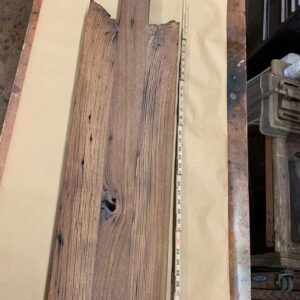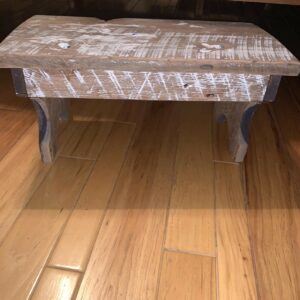$189.95
American Chestnut Charcuterie, Cheese, Serving Board/Tray, Extra Large
American Chestnut Charcuterie, Cheese, Serving Board/Tray, Extra Large
This unique, extra Large, handmade in America charcuterie serving/cheese boards is made from very rare American Chestnut 2x4s I salvaged from a house in West Virginia 45 years ago. (See below for a short history of the American Chestnut Blight.) I included pictures of the process in reverse order and actual 2x4s used. Even the leather loop on these exquisite boards is repurposed, coming from a discarded bull whip. I estimate this wood to be about 115 years old.
Size: 2”x 11”x 40”
All of my serving boards are finished with approved food safe products, oils and waxes.
*Serving boards made from reclaimed wood are not recommended as cutting boards.
The pictures here are intended as a representative sample for my American Chestnut serving boards. You will receive a board made in the same process, the same size and of the same type wood as the sample. All of these boards are handmade by me from 100% reclaimed American Chestnut, therefore each item is literally one of a kind with different wood characteristics and individual reclaimed attributes including but not limited to grain, color, dimensional uniformity, checks, splits, cracks, holes, knots, warp, twist, bow, cuts, scrapes, scratches etc. No two pieces are the same so please consider this before you order.
If you’re interested in a custom size board I can make these in virtually any size you need. Bravo Company Shops is a full service shop specializing in antique restoration and unique builds inspired by the characteristics of each piece of reclaimed wood. I am not a factory with an assembly line, I am one person who enjoys making things with my hands. My shop is very informal, my processes are simple. If you want a custom board give me a call and we will work out the details the old fashioned way; by talking.
History of the American Chestnut
The history of The American Chestnut Foundation (TACF) chronicles the ongoing pursuit of a fundamental goal: to develop a blight-resistant American chestnut tree through scientific research and breeding, and to restore the tree to its native forests along the eastern United States.
More than a century ago, nearly four billion American chestnut trees were growing in the eastern U.S. They were among the largest, tallest, and fastest-growing trees. The wood was rot-resistant, straight-grained, and suitable for furniture, fencing, and building. The nuts fed billions of wildlife, people and their livestock. It was almost a perfect tree, that is, until a blight fungus killed it more than a century ago. The chestnut blight has been called the greatest ecological disaster to strike the world’s forests in all of history. The American chestnut tree survived all adversaries for 40 million years, then disappeared within 40.










